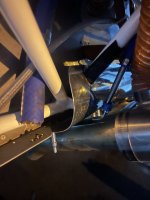My question is do Millennium cylinders tend to run hot? Hotter than Lycs? How much hotter?
My 6th RV-7 is now flying. Prior builds used 360s and 375s with ECI jugs or Lycomings flowed by Lycon, up to 9.6:1, with updraft RSAs or carbs. This one, "Gooney Bird", a Superior IO-360-M1B has a cold sump, FM-150 servo, 9:1. My other aircraft would run in the 350-390 range (ambient, power, speed, leaning variables). #6 has cruise CHTs into the 400s in 40 degree ambients; in short, unserviceable. Its temperature range is barely affected by such experiments as blocking advance by the P-mags and retarded timing to 20 BTC. (Yes, the P-mags are on TDC for set-up. I've verified that the ring gear's timing marks are correctly positioned.) Allowing the A curve advance and such curiosities as removing the lower cowl intake seals had NO effect on CHTs. Seems air's just not getting through the system.
Gooney under the cowl looks like all the other happy installations except for the Superior engine and the Vetterman exhaust system accommodating the horizontal sump; it seems to have more piping across and near the cowl exit that it might be blockage. My suspicions start with the cylinders themselves.
Any thoughts?
Anyone want to buy a hot RV-7?
John Siebold
My 6th RV-7 is now flying. Prior builds used 360s and 375s with ECI jugs or Lycomings flowed by Lycon, up to 9.6:1, with updraft RSAs or carbs. This one, "Gooney Bird", a Superior IO-360-M1B has a cold sump, FM-150 servo, 9:1. My other aircraft would run in the 350-390 range (ambient, power, speed, leaning variables). #6 has cruise CHTs into the 400s in 40 degree ambients; in short, unserviceable. Its temperature range is barely affected by such experiments as blocking advance by the P-mags and retarded timing to 20 BTC. (Yes, the P-mags are on TDC for set-up. I've verified that the ring gear's timing marks are correctly positioned.) Allowing the A curve advance and such curiosities as removing the lower cowl intake seals had NO effect on CHTs. Seems air's just not getting through the system.
Gooney under the cowl looks like all the other happy installations except for the Superior engine and the Vetterman exhaust system accommodating the horizontal sump; it seems to have more piping across and near the cowl exit that it might be blockage. My suspicions start with the cylinders themselves.
Any thoughts?
Anyone want to buy a hot RV-7?
John Siebold


